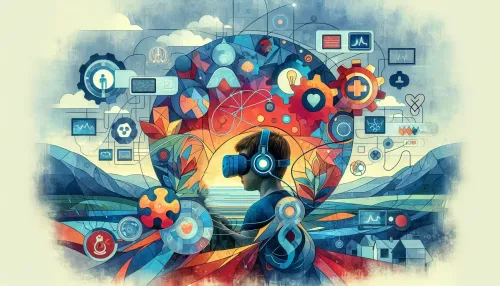Enabling Autistic Voices: The Evolution of Communication Technology Aids

Communication for many children with autism has been transformed thanks to advancements in technology. The HorizonsMind Blog delves into these revolutionary tools and technologies that support autistic children's ability to express themselves, enabling them to harness their unique voices. It's a realm where silence is broken by the touch of a screen and the power of innovation.
For children who struggle with traditional speech, Augmentative and Alternative Communication (AAC) has been a game-changer. AAC includes various methods of communication, from picture boards to electronic devices, that supplement or replace spoken language. Progress in AAC technology now offers personalized experiences that are shaping the way autistic children interact with the world around them. This integration allows non-verbal children to express their needs, share their thoughts, and participate in education more fully.
Augmentative and Alternative Communication (AAC) Tools
Speech-generating devices (SGDs), a subset of AAC, have evolved considerably. They now feature advanced functionalities such as voice banking, allowing users to communicate with a voice that sounds like their own. Newer models come with eye-tracking software perfect for children who also have motor limitations. Each innovation brings more nuanced and natural methods of communication to autistic individuals. Companies typically highlighted on the HorizonsMind Blog, like Tobii Dynavox or PRC-Saltillo, constantly push the envelope in what SGDs can achieve, making them more intuitive and user-friendly.
Revolutionary Speech-Generating Devices (SGDs)
With the ubiquity of smartphones and tablets, language development apps have become a staple in supporting verbal skills among autistic children. Apps such as "Endless Alphabet" or "Speech Blubs" employ interactive challenges and engaging visuals to entice users to expand their vocabulary and pronunciation abilities. These platforms offer a sense of play while learning, which has shown to be highly effective.
Customization is key when it comes to AAC devices and software. The ability for parents and therapists to tailor these aids to align with an individual child's preferences – such as adjusting sensitivities or personalizing vocabularies – ensures the tools grow along with the child. As we address in the HorizonsMind Blog content series on personalization, technology developers are increasingly recognizing the diverse spectrum of autism and are thus offering options that adapt to varied cognitive styles and learning paces.
Related Article: Wearable Tech Advancements: Empowering Autistic Children with Innovative Therapeutic Interventions
Language Development Apps for Autistic Children
For those who use sign language or are interested in learning it, technological boosts have been remarkable. Innovations include gloves that translate sign language into text or speech, and apps that teach and recognize sign language through AI. These technologies not only aid autistic individuals but also educate others in understanding and communicating using sign language.
Customization of Communication Aids: Meeting Individual Needs
Sometimes communication extends beyond words and tech is there to help bridge that too. Sensory tools like LAMP (Language Acquisition through Motor Planning) focus on consistent motor patterns for communication, ideal for individuals with motor planning difficulties. Digital art programs and music creation tools also provide alternative means for self-expression and communication without relying solely on verbal language.
Innovations in Sign Language Technology
The involvement of end-users in AAC technology development has led to user-centered design principles taking front stage a trend heartily embraced by HorizonsMind Blog advocates. These principles ensure that products are not just innovative but also accessible, practical, and tailored for real-world application by autistic individuals. Understanding user feedback is paramount in creating solutions that truly serve those intended.
It's through success stories that we gauge the true impact of these technologies. Personal accounts detailed on HorizonsMind Blog give us insight into how these aids can be life-changing like how a speech-generating device enabled a child's first spoken "I love you" or how an app helped another engage with peers at school meaningfully. Such anecdotes serve as potent testimonials to the transformative potential communication technology holds in enriching the lives of autistic children and their families.
Empowering Non-verbal Communication with Technology
The journey of technological advancement continues as researchers, developers, therapists, and families collaborate toward enhancing life experiences for autistic individuals through improved communication tools a mission at the heart of what we celebrate at HorizonsMind Blog.
Frequently Asked Questions
Augmentative and Alternative Communication (AAC) refers to various methods that support or replace spoken language for individuals who struggle with traditional speech. This includes tools like picture boards and electronic devices, enabling non-verbal children to express their needs and thoughts effectively.
Speech-generating devices (SGDs) have significantly advanced, incorporating features like voice banking and eye-tracking software. These innovations allow users to communicate more naturally and intuitively, catering to the unique needs of autistic individuals, especially those with motor limitations.
Customization is crucial as it allows parents and therapists to tailor AAC devices to meet individual children's preferences and needs. This personalization ensures that the tools adapt alongside the child, enhancing their communication experience and supporting diverse cognitive styles.
Check Out These Related Articles

Embracing Virtual Therapies: Enhancing Autism Care in the Digital Age

Adaptive Technologies in Autism Care: Innovations from Urban Centers

The Evolution of Speech Therapy: Harnessing Technology for Effective Communication Support in Autistic Children
